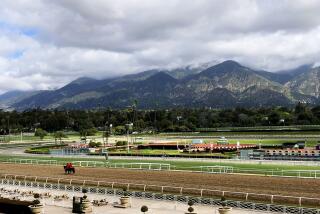A Primer to Oaks Classic
- Share via
Show-jumping pits horse-and-rider team against series of obstacles and clock. Winning team is one with fastest time and fewest penalty points.
Typical Course
Once start bell sounds, round must begin within 30 seconds. Horse should be alert and cantering in lively, controlled stride. Obstacles can be as high as six feet and as wide as six feet. There may be 12 to 20 obstacles, including fences, water ditches, walls and combinations. Course may change between rounds.
Walking the Course
Before each round, riders may walk course along line they intend to ride. Taking three-foot steps (there are four to average horse’s canter) rider estimates strides between obstacles and most difficult jumps.
Oxer: Two or more vertical jumps several feet apart; tests height and width of horse’s jump.
Vertical: Tests ability to jump height.
Water jump: 12- to 14-foot-long shallow ditch filled with water; tests width of jump.
Combination: Series of jumps set within stride or two of each other.
Design Tricks
Course-builders set up obstacles to deliberately confuse horse. Some examples:
White fence against the background of white judging tent makes horse think it’s jumping into solid white wall.
Red obstacle is placed in direct line of sight of red car outside course to throw off horse’s depth perception.
If final obstacle faces collecting ring, horse might be too eager to complete clean jump.
Good Jumping Position
Although there are no grades for style, knowing what gives rider near-perfect jumping position adds to aesthetic enjoyment of sport.
Look straight ahead, between horse’s ears.
Position over horse’s center of balance.
Maintain slight, relaxed contact through reins to horse’s mouth.
Tendon boots, made of sheep-lined leather or synthetic material, are strapped to horse’s legs to prevent injury from hitting obstacles.
Scoring
Faults (points) are assessed for various infractions on course. Also, there is prescribed time limit for each round. Penalty for exceeding time is 1/4 fault for each second. Other penalties:
First refusal: 3 faults
Second refusal: 6 faults
Third refusal: Elimination
Knockdown of obstacle: 4 faults
Foot in water: 4 faults
Horse or rider fall: Elimination
Oaks Classic Purse
1st place: $15,000
2nd place: $11,000
3rd place: $6,500
Show Information Tickets
General admission: $8 at gate for Sunday, June 5, only.
Patron tickets: $150 (includes food and entertainment).
Parking: General admission along street and in lots; valet parking for patrons only.
Schedule of Events
Saturday:
4 p.m.: $7,500 “Dash for Cash”
Sunset: Thoroughbred Spread Barbecue, Calcutta*
Sunday:
8 a.m.: Hunt breakfast*; $10,000 Regular Working Hunter Stake; $10,000 Regular Conformation Hunter Stake
11 a.m.: $10,000 “Acorn” Junior Amateur Grand Prix; presentation of winners
Noon: The Oaks Classic Grand Prix luncheon*
2 p.m.: The Oaks Classic $50,000 Grand Prix
* For patrons only
Sources: “Riding School” by Pam and Lionel Dunning; World Book Encyclopedia, Oaks Classic; Researched by APRIL JACKSON / Los Angeles Times


